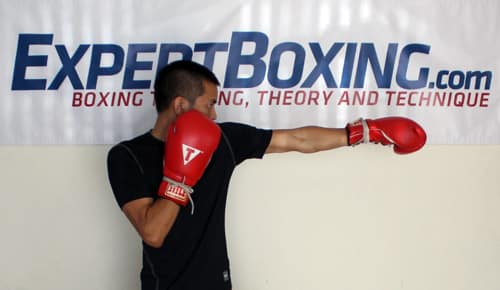
While the jab isn’t as exciting as the cross, hook, or uppercut, the jab is more useful than all other punches combined. The jab can punch, push, distract, create openings, or even defend against your opponent’s deadliest punches!
Here is my official boxing guide on throwing a proper jab. It’s complete with pictures, videos, and explanations for all the common nuances of the jab.
Learn how to throw your #1 punch!
I don’t remember what I wrote on the jab 4 years ago when I first started the website. That was 2008, this is 2012. I look to re-do many of these basic guides with newer and more complete boxing instruction. Thank you for your patience!
Basic Jab Technique
The jab is a boxer’s most important weapon!
In case you haven’t heard it before: the jab is your #1 weapon! But WHY is it your number one weapon?
Compared to ALL OTHER PUNCHES, the jab is faster, longer, most likely to land, and least likely to leave you vulnerable. The jab uses less energy than any other punch and still keeps you in position to follow up with a dangerous power punch (ie: the right cross). You can use the jab to punch, to push, or even to distract. It’s accurate and effective from many angles even if you have limited skill. Do you know of any other punch that is still equally effective when thrown while moving?!
The jab isn’t just an offensive weapon, it’s also your best defense! Instead of blocking or slipping or rolling, you can counter just about any punch with the jab! The jab can do everything: your offense, your defense, your entire boxing ability can measured by the skill of your jab.
Although there are many different types of jabs and many different ways to throw them, this guide will focus only on the BASIC JAB TECHNIQUE!
How to Throw a Jab
1. Stand in your boxing stance

Hands up, elbows in, hips between your feet, knees slightly bent, and back heel lifted. Front foot at slight angle generally pointing towards opponent, back foot about 45 degrees diagonal. (Note that my back foot doesn’t look very diagonal because the heel is lifted, making it appear more like 90 degrees.)
- Basically, all you need to do is get in your stance and do nothing else. Do not try to “load” the jab by pulling your front hand towards you or lowering your hips, or otherwise preparing yourself in any other way.
- If you don’t know what the basic boxing stance is, read my guides on boxing stance: The Perfect Boxing Stance & Perfect Boxing Stance Width.
- Oh and please, keep the body and hands relaxed.
The beauty of the jab
is that you’re always in position to throw it.
2. Extend the glove

Now extend (PUNCH) your front glove (left hand for orthodox, right hand for southpaws) towards your opponent, while exhaling a sharp breath.
- NOTHING ELSE MOVES. Move only your front arm, and none of your other limbs. Do not shift your weight forwards or backwards, keep your weight at center.
- The extension is the speed portion of the jab. It has to be relaxed and fast. If you tighten your fist too early or visualize your fist becoming a brick and hitting your opponent, it decreases your jabbing speed. Try instead to imagine your fist cracking upwards and forwards like a fast whip, with your knuckles slapping upwards at your opponent.
- Visualize this “upwards snap” with only your hand, NOT your entire arm! Do not try to hit with the top of your head, lead the punch with your knuckles. If you feel unable to jab powerfully, try to focus more on your arm rotation and tightening of the fist than the whipping motion of the fist.
The most relaxed jab is the fastest jab.
3. Rotate your arm
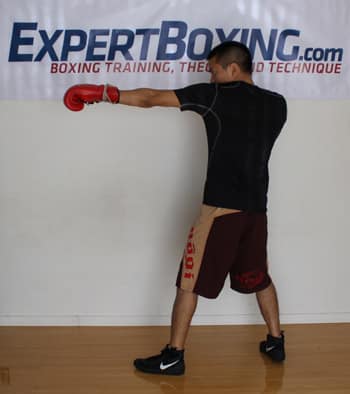
Ok, it’s about to get tricky for you beginners! While the glove is extending outwards, ROTATE YOUR ENTIRE FRONT ARM so that your punch lands with the palm facing down and your shoulder rotated up to cover your chin.
- You will be rotating your entire arm, the shoulder, the elbow, the fist.
- Rotating the shoulder is what allows the rest of the arm to fully rotate. Instead of only rotating the shoulder, try to LIFT your front shoulder. Lifting the front shoulder gives you more reach and also protects your chin from overhand counters. It’s a good habit to develop for new fighters because they often leave the chin exposed when throwing the jab.
- Bring the elbow straight up into the jab instead of sideways. The straight elbow solidifies the jab and gives it a direct angle of attack. When you rotate the elbow quickly, it adds snap and power to your jab. The arm will also telegraph a lot less because your elbow is coming straight behind the jab as opposed to swinging upwards beforehand. (If your elbow keeps swinging out because you don’t rotate, try throwing jabs while standing with your left side against a wall. This will prevent the “chicken wing” effect.) Again, bring the elbow forward (instead of sideways) so your jab comes out straighter for better power, less telegraphing, and straighter penetration force.
- Rotate the fist for power and snap. You don’t need to visualize the arm drilling a hole in your opponent. Your arm rotates because your arm cannot comfortably throw a forward punch with the palm facing upwards. Think about it, your jab starts with your palm facing you, and then your arm rotates during the jab, and then the jab lands with your palm facing down. The rotation should feel natural; the fist rotates because your arm rotates!
- Tighten your fist right at the moment of impact. The fist tightens and entire body contracts explosively only for a split second at the moment of impact! If you tense up before the impact or beyond the impact, it slows your speed, reduces power, and wastes energy.
Rotating the entire arm
provides power, form, and defense!
FINISHED JAB!
I know I broke the jab down into 3 steps but in reality, it all happens simultaneously. Your arm extends quickly outwards as it rotates, and your jab lands with a tight fist and rotated arm right simultaneous with a sharp exhale. The result is a sharp snapping jab!
- Once you finish the jab, pull it straight back to continue attacking or defending!
*** Watch my video above to see some live demonstration of a proper jab!
Common Mistakes with the Jab
Mistake #1 – elbow comes out sideways aka the “chicken wing”
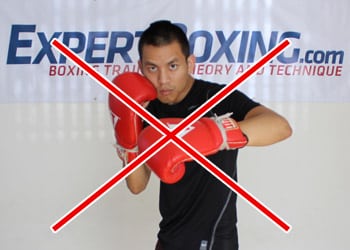
BAD! Don’t let your elbow fly out like that. I know you’ve seen the pros do it on TV or maybe you discovered it yourself as a cool way to whip your jab up while your hands are down.
Here are some problems you’ll find with a “chicken wing” jab:
- Less power – pros can do the back-slap jab because they’re just throwing their left hand out there while waiting for to throw their right hand. They’re using it as a touching jab. For now, beginners need a proper jab with sufficient power.
- Telegraphs – anybody can see it coming. Sticking that elbow out makes it really easy to see and really easy to parry the jab because you’re throwing your whole forearm instead of only the glove. Anytime I see someone throw a chicken wing jab, I no longer have to block the glove because I can just slap their forearm down everytime that elbow comes up. Your jab might also be slower because the elbow is coming out sidewards instead of straight forward into the punch. (The pros do it quick sometimes by leaving the elbow out there and just back-slapping with the hand.)
- Bad form – the chicken wing jab isn’t only less powerful and less speedy, it’s also less direct. The jab won’t be as straight and cannot force it’s way cleanly inside a tight guard. There may be moments in your fight when you need a really straight jab to push forward, and a sideways elbow won’t allow the angle or stability for that.
Mistake #2 – dropping the right hand
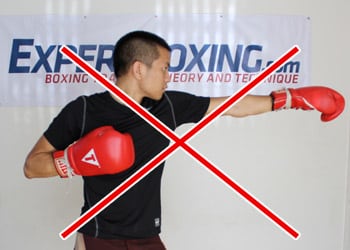
WHOA! How did this happen? Everybody knows what this clown is gonna throw next! Anyway, dropping your right hand is just plain dangerous. It leaves you vulnerable to left hook counters and telegraphs your right hand follow-up. A longer armed opponent will easily counter all your jabs with left hooks.
- Keep your right hand by your face when you jab. A good trainer will drill this bad habit out of you on the mitts from day one. My trainer used to slap me with left hooks anytime I dropped my right hand; not just during jabs.
Mistake #3 – reaching with the head
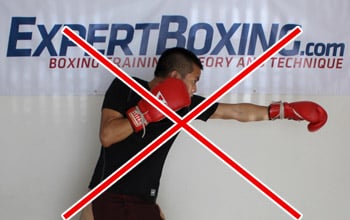
Many fighters do this for reach or power. Hey, it works if you want to steal a quick point or have some tactic behind this. In terms of general boxing purposes, this is bad technique.
- Decreased power and balance – leaning forward reduces your power because you’re falling towards one leg instead of staying on two. This creates less balance and makes it even harder for you to recover your stance (pulling the hand back is easy, pulling your head back might not be).
- Decreased right hand power – Leaning forward also means you’re taking weight off your back foot. This will make it harder for you to throw a right hand since you have no weight back there to powerfully rotate into a right cross. You’re only option to throw a powerful right cross is probably to lean even further forward. One day you’ll pay for this!
- Vulnerable – you’re already vulnerable by throwing a punch, but to come forward with it makes you especially vulnerable! First off, it’s common knowledge never to bring your head forward with your jab. A good opponent will knock you out with a perfectly timed right hand because you threw yourself into it.
- A wise rule would be to keep your head BEHIND YOUR SHOULDER. Try it again, throw a regular jab and keep your head back—see how the shoulder comes up to protect the chin? Now lean forward with the jab and now the head is next to the shoulder with no protection.
- If you want to come forward or have better reach, use a step-jab so you have even more power and don’t sacrifice any balance or unnecessary vulnerabilities. (A step jab means to step forward with your front foot as you throw/land your jab.)
Mistake #4 – not lifting the shoulder
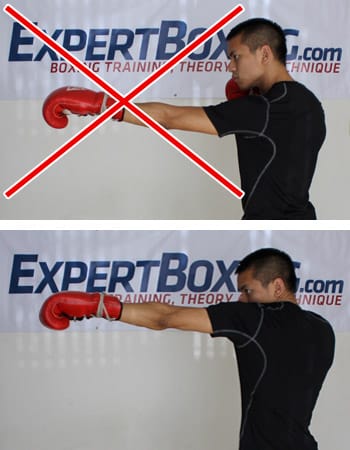
See the difference between lifting the shoulder vs not lifting the shoulder? It results in less power, less reach, less rotation, and even leaves your chin open to counter rights. Beginner boxers should be drilled until they no longer make this amateur mistake.
Mistake #5 – popping up with the jab
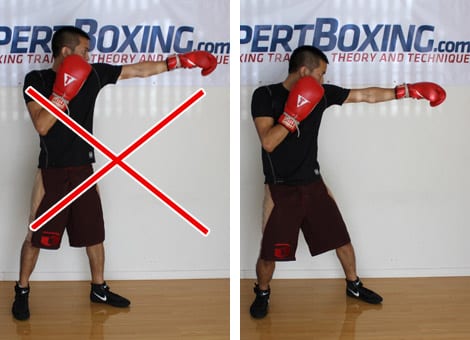
WHOA! Why are my legs so straight?! Why am I trying to stand up so high?! Many beginners commit this crucial mistake because they were taught that punching power comes from the legs. This is true but it doesn’t mean you should straighten your legs while punching.
Straightening your legs during the jab results in:
- Less grounding – well you’re obviously going to have less balance and less power because you uprooted yourself during the punch. If anything, you need to stay down so your legs can exert more force against the ground—especially during the moment of impact! Go over to a heavy bag and try hitting while you pop up. Then try it again while you stay down (or even drop an inch). Which one has more power and balance? 😉
- Less control – if you pop up, you won’t be able to quickly move from your position or go into other punches or bob & weave, etc. Stay down so you can be more grounded and able to move yourself powerfully.
Mistake #6 – rotating the foot or body
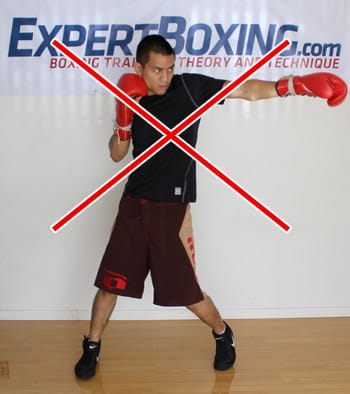
This isn’t bad technique, it’s just not a jab. Rotating the foot and body gets you a totally different punch called the “left cross”. Most beginners will probably resort to this technique in effort to increase their jab power. The jab is straight, fast, and surprising. A left cross is rotational power making it hardly any different from all your other punches.
The left cross definitely has more power but lacks many of the jab’s qualities:
- Speed – a left cross requires more body movement than a jab. It will take more time and more energy. Being that all your non-jab punches are power punches, you should really let your jab do all your speed work for you. Don’t worry about power, the jab will set up your power punches for you!
- Right cross reaction time – the right hand is faster after a jab than after a left cross. The reason is simple: during a proper jab, your body does not rotate however during a left cross, your body rotates in the opposite direction of your right cross which slows its release.
- Left hook reaction time – now that you already wasted your rotation on a left cross, you can’t follow your jab with a left hook. Well you CANNNNN, but it won’t be as fast. It’s better to keep that body stable and not waste any energy until you see openings for the more powerful punches.
- Variety – The jab is beautiful as it is. Where it lacks in power, it makes up in utility. There are many variations of the jab that all incredibly fast and useful in infinite situations. It would be a poor strategic decision to give up all of the jab’s qualities for the sake of power.
The left cross is not a jab,
not even a more powerful jab.
Variations of the jab
Here are some fun variations to the basic jab. You will need to master ALL of these in order to be a successful boxer! (Note: I’m not putting any pictures for these because they will have their own instructional guides later.)
Step Jab
The step jab will most likely become your number one punch because it’s fast, powerful, and brings you into range. It’s more powerful than your regular jab and also has more reach because you’re stepping forward.
The most common mistake is to try and step too far. What ends up happening is that your punch lands before your foot hits the ground and you have less power OR you get countered or pushed off balance because you were floating during the jab.
Try standing just outside your opponent’s reach and then using only a very tiny step to bring yourself in range. This is what makes you fast, powerful, AND EFFICIENT! The pro’s take small steps, not giant ones that leave them vulnerable in the air.
Step jabs have more power and reach than regular jabs,
making them your #1 weapon!
How to throw a step jab
- Step forward with your front foot (just a few inches) as you throw your jab.
- Recover your BACK FOOT as you recover your front arm.
- Every step jab should take you a few inches closer to your opponent.
***Note: you can also throw back-step jabs. Jab while stepping back with your BACK FOOT and recover the front foot as you recover your front arm.
Body Jab
The body jab is incredibly useful for scoring body shots, distracting your opponent downstairs to land right hands upstairs, or even pushing him off balance. The body jab is also a natural counter to the jab. The common mistake is to telegraph your jab to the body by looking down at his body (instead of his head) AND/OR crouching down too low when you do it. If anything, you crouch down only enough to avoid his oncoming punch (like a jab). Otherwise, getting low is not necessary to land body punches!
Body jabs can punch or PUSH your opponent.
How to throw a body jab
- Start from your natural boxing stance, do not crouch down!
- Throw a step jab but bend at your knees and waist as you aim your jab at your opponent’s body. Taking a small step allows you to get lower without having to bend over so much AND it helps you drop your body weight into the punch.
- The body is a softer target than the head, so you need more of a pushing jab than a snapping jab to hurt it. You can “push” a little longer as you dig your jab into his body. This can even push him off balance if he blocks it.
Pivot Jab
The pivot jab is useful in both offensive and defensive situations because it allows you to attack your opponent while angling yourself out of the way. Offensively, pivot jabs allow you to attack while circling your opponent. Defensively, pivot jabs allow you to counter attack as you move your body out of the way.
The most common mistake for pivot jabs is to over-rotate. Jabs thrown with a wide pivot have less power because you were floating too much on one leg. Pivoting too wide can also turn your back towards your opponent AND/OR make it harder for your right hand to reach. Unless your pivot jab is purely for escaping the corner and spinning your opponent, smaller pivots are usually more ideal. The general idea is to pivot only enough to avoid your opponent’s attack, otherwise your focus should be on grounding the feet as quickly as possible to counter.
Pivot jabs allow you to attack
while moving out of harm’s way.
How to throw the pivot jab
- Throw a jab while simultaneously rotating your body as your back foot swings behind you. This will cause you to pivot clockwise (for orthodox boxers) or counter-clockwise (for southpaw boxers).
- As you pivot, allow your opponent’s punch to miss into the space you just occupied. The pivot jab will require some timing skills.
Power Jab
The power jab is a difficult and crucial skill to master. It’s probably impossible that you can learn it from this brief guide but here is how it works. The power jab is simply a jab thrown while grounding the body downwards. It is a jab thrown while your hips are projecting force downwards!
In moments when you see an opportunity to land a jab but nothing else, the power jab will make a great impression. In all other moments, it’s best to land a fast jab and follow immediately with the right cross, left hook, etc. In other words, the power jab is great for POWER potshot-ing.
The most common mistake is to try and use power jabs as your normal jab; you end up waiting for opportunities instead of creating them with lighter faster jabs.
The power jab is useful for landing single shots,
but not for combination punching.
How to throw the power jab
- Throw a jab while slightly dropping your hips. It might FEEL like a free-fall.
- Allow this hip drop to happen simultaneously as you throw the jab.
- In the moment of impact, your jab lands as your hips and legs exert a LITTLE BIT of downward force to counteract your fall. Your jab lands as you “catch” your hips. Again, your hips and legs are only EXERTING FORCE–they are not actually moving…and you do not stand up or otherwise move your hips from their position. The power jab is something you feel, not something you see.
Final thoughts on the jab
It doesn’t matter what style of fighter or what level of fighter you are. The natural game of boxing gravitates towards a jab fight. Whether you like to box or brawl, throw in high volume or high power, attack or defend, you will need a jab. A stronger fighter needs a jab to create openings for his right hand just as a weakened fighter needs a jab to keep his opponent away. The jab is essential whether you’re trying to win by knockout or decision.
Lower-level fights are usually about power and endurance. Higher-level fights are usually about speed, accuracy, timing, range, and skills. I don’t have to tell you what the fastest, longest, most accurate punch is in boxing. The better you want to get at boxing, the better your jab must be!
The more skillful a boxing match,
the more important the jab becomes!
FINAL JAB TIP: The jab is for boxing, not fighting.
Don’t jab in a way that puts you off balance or exposes you, or prevents you from using your more powerful punches. The jab is not the best weapon because you can trade punches with it; it’s the best weapon because it KEEPS you from having to trade punches!





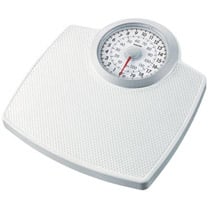
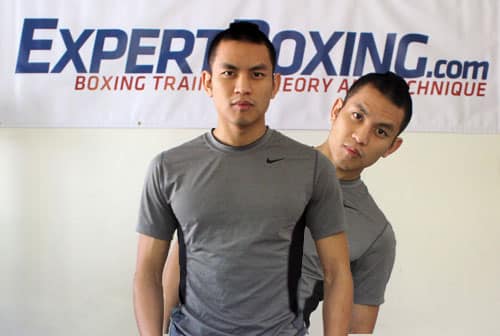
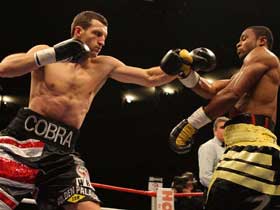
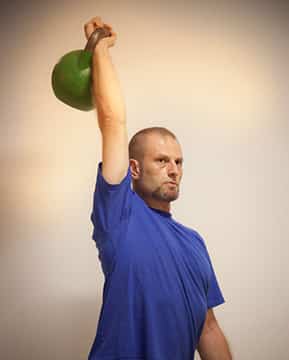
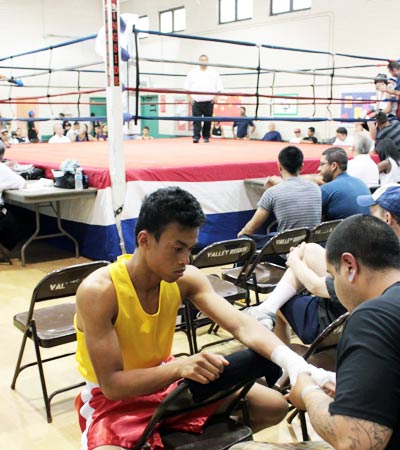
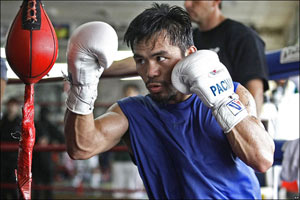
Great article man! I was wondering if you ever watched mayweather at 130 lb?….. His nab is awesome and I would love to hear your thoughts and tips on how to throw the step jab like that. He sits on the outside and with his left low steps in very quickly and shoots a fast jab and then gets out. If you watch him vs Diego corrales his jab was unstoppable. I’ve been trying to perfect it but I can’t get in and out as fast as he can and his stance seems a lot wider than what I’m comfortable doing. Any advice will be appreciated.
Yes I have, great jab, great footwork. He stands and fights more like a long-limbed preying mantis and leaps in and out range like a cat!
His drop jab and body require some proper balance and footwork skills. Once you know how to ground yourself powerfully, it’s pretty easy to push an opponent back with a hard jab.
How does he stay at that range and make his opponent stay at that range? It would be awesome if I could figure out a way to stay out of range like that for most of the round
The simple explanation is that he punishes them when they get close. Vicious counters thrown with deadly accuracy and intent. Many of the opponents are cautious because they’re still trying to figure out how to crack that defense.
This is my first time performing this jab and my shoulders end up in pain quickly or tire out. Is that normal?
First timer? Yeaup, you’re supposed to tire out quickly if you’re not used to something. Get the form down perfect and then find a way to relax or at least not hold too much tension.
What should I practice next after the jab?
The first boxing gym I went to was quite a tough one in fact my boxing coach was a man that everyone respected and made me perfect the jab in one day and my i couldnt workout the very next day and the truth is that in boxing no ones ever perfect, that’s why you train to improve all the time. The first time is all ways the worst and the hardest in my opinion though it may not be as intensive as an elite level performer’s type of training, it’s the adaptation from a sedentary lifestyle to one that’s so touch it actually matures you.
Very good article. And as for me it’s very useful, as a boxer with dominant right eye and more strong left hand (as in common life i’m a lefty) I choose orthodox stance. And right now i’m working on how to throw faster and lighter jabs by left hand, otherwise my right cross make me and my coach sad.
Also as a newbie i was concentrated on foot work and rotating the body that is why all my punches was equally loaded with power (as i’m understanding now even too overloaded).
Once again thank you for helpful article.
P.S. Sorry if my english is not good for understanding. Greetings from Russia.
Ali had a good jab as well did Holmes and Floyd Mayweather’s jab to the body was irriputably as solid as a rock but who were better jabbers who do you think I should look to for insperation and in what fights?
i was kind of thinking:
* Sonny Liston against Cleveland Williams
and George Foreman against Joe Frazier
what do you think?
I wouldn’t go around looking for better jabbers but maybe look for different kinds of jabbers. Short-armed, long-armed, fast jabs, power jabs, etc. There are so many out there…study and learn everything!
what do you think of larry holmes jab here https://www.youtube.com/watch?v=0rHA0rq221Y? I think he was the greatest jabber ever, How can I use my jab to the head to open my opponent for more sucsessive body attacks for loinger periods or more often.
It’s a great jab.
No one ever remembers one of the best boxers who was amazing at jabs, even if he did bite an ear off… Iron Mike.
if there was ever a master article on the jab, this is it. Thanks, Johnny.
From the sound of your video, your jab causes women and children to cry. I hope to achieve this level!
That sounds about right because this jab was trained to make grown men cry! 😉
A few weeks ago I tried sparring using nothing but the jab, at first I thought that I would be predictable and get clobbered (he knew my game plan beforehand), but the opposite happened. I danced arounded raining a volume of jabs practically overwhelming him, and every time my opponent would fight back I would see it coming (by keeping at range), slip (or step back) and counter jab. I felt like Ali, the jab is definetly now my favorite punch.
Keep dancing! Start learning all the jab tricks!
thanks for the tips, johnny. i’ve been reading your articles for over a year and its helped me alot with my boxing. what gym are you going to be training at in SF??
I have no idea right now. I just got here and don’t quite know the area yet. It’s kind of sad to train without my usual crew.
i feel you man. if you need anything, let me know! i’ve boxed at a few of the gyms in SF and i can introduce you to some good people in the SF boxing community if your interested. the city is an awesome place to live!
Please let me know. I’m definitely looking for a gym and new trainer to learn more boxing techniques. Thanks, Nehemiah.
Watching Hagler’s fights, he seems to use the lead hand right cross very successfully. He would often square up ready to cock the lead right hand with rotational power, a technique often seen in street fights, as it is the safest way to throw with power without getting hit.
Timing it as your opponent moves forward could be a knock-out punch, particularly without gloves.
Do you ever use this in sparring?
You ever coming down to Australia?
I do load up my hand at times in sparring. Sometimes when you pull it back, your opponent can’t tell what direction it’s coming from.
I’d love to come down to Australia one day. We’ll see…
awesome post Johnny. The jab is the punch that i have trained the most and still havent perfected it yet. I am slightly better with other punches though.
Btw my coach told me to throw the jab while leaning very slightly towards the right for more power (slightly using the hips). Is this considered the normal jab ?
My first trainer used to tell have me lean my head to the right as well. It was more tactical purposes than for power purposes. When you have your head tilted to the right, it can be easier to slip under punches and return a counter jab while your opponent’s jab slides over your neck. It’s also good for baiting long right hands and then you transition into a roll-under. I don’t always do it, though. There are times when I want my head straight up or tilted to the other side for other purposes.
Johnny..I practiced a few jab basics last night that I was lax on such as really turning into and lifting the shoulder, etc. Raising the shoulder really intensifies it and adds an extra layer of defense. Makes a world of difference.
very nice article sir, in what ive read jab to the body is a natural counter for an oponents jab. what if the scenario is this, my oponents countered my jab to the head with his jab to the body. since I have a strong abdominals, I can resists his attack, let him counter then i go with a right straight to his head. is that possible?
don,
i thought about that before but my coach told me that boxers who are good at playing angles bob their heads up and down very quickly. throwing a straight towards their head while they jab your body leaves your chin open to his uppercut and left hook (if you throw downwards to his head n miss). Good boxers know how when to move their head up and down and vary the angles so opponents cant hit them. That is what i feel, correct me if I am wrong
Yes, some people will do that at the beginning of the fight. They give you a free body jab but then they attack viciously with right-left-right to your head. It can really catch you off guard if you were just trying to score a nice little body shot downstairs. I’ve heard this being call the “sucker punch” tactic before. Let him go for your stomach with a weak jab and punch him right in the face.
jhonny hello, can then make a new item on the left hook? thanks
On the way!
Your articles are TOO good. They’ve helped me so much in Muay Thai training.
Hello Johnny,
I thought I’d share my trainers style of teaching the jab.
Regards to balance it is the same. Back foot on it’s ball, steady sink C.O.G in hips, dropping with an elusive lower sink when you move.
However the lead foot doesn’t sit/ step flat when you shoot, it stays on it’s ball, giving that little extra weight from the sink.
In regards to boxing in general though I believe there is no perfect punch, only a perfect opportunity, created or otherwise.
Practise to develop my jabbing “ability” not necessarily my technique. Helps to keep the broader picture in mind. Something regarding seeing leaves not trees and trees not forests seems familiar here… 😉
I also appreciated the like-mindedness of your article on dancing. I started ballet the same time as boxing to round out my passions. “A man must learn to love before he can learn to fight. But a man will only be great once he respects the vulnerability of both.”
Love from Australia.
Thanks for the input, Blondie.
The front foot is definitely something that varies between different fighters. Some people like being on the ball for more speed or control of movement. Others like it flat for stability. For beginners, I recommend having the front foot flat.
do you have some video or somethin? i started boxing with my boss in germany like 1 year ago. He learned it from a russian instructor and he told me the whole time to stay on my balls while practicing with the punch bag. i also learned to jab with a step from the lead foot and then going back to the original position. I am not so sure if i had to be flat food at the moment of punching, i guess that depends on the type of jab. what do you think? thanks!
There are so many ways to answer this question that it would take me hours to explain everything. The easy answer is…there are many ways to do things. Different methods come with their own pros and cons. Try different things and see what you learn. This trial and error is what gives you true “experience” and understanding of fighting technique.
i like this jab, it teaches a stiff long jab 🙂
Brand new to boxing. Concentrating on the basics. Very good detailed explanations of the various Jabs. I will be coming back to this article for reminders & perfecting my style.
when you post a new article on the left hook??
Probably not for a couple weeks. I did post a video on my youtube though.
Tommy hearns used to jab from the hip at times
what gave it so much power?
A power puncher is going to have power regardless of the punching technique being used (assuming it’s good technique). Usually people jab from the hip for tactical purposes, not technical purposes.
Hi Jonny! thank you for your site and this great guide. i’m a newbie in boxing and my left shoulder is too weak: after just a few jabs it starts burning and my jabs became lazy and slow.
can you suggest me some simple home workout to improve my muscles? I can go to the gym only twice a week so having some simple everyday exercise would be great.
Give it some time and the hands will develop better conditioning. For the shoulders, do the speed bag more often. As for everyday exercise, start doing more shadowboxing!
I’m curious how snapping punch with jab is done. I don’t do boxing for serious, but I just wanted to know if I done the snapping punch right. I know might be suitable to be posted in ‘How To Throw a Snapping Punch’, but I just wanted to focus on this punch first. I have seen a guy on youtube on how to throw the correct jab. Here’s the link: https://www.youtube.com/watch?v=Ky-tYuZR9c0
In the video, the guy have his thumb facing the floor a bit which make it look like he’s throwing it vertically. I find out that to be ridiculous at first. When I first started, I hurt something at the elbow. I find myself struggle to recover my hand. But recently, I try to jab by relaxing everything and start from my shoulder( i try to ignore the fact that i have an arm). I find out that I did what the guy on the video did. I don’t force the recovery and my hand is fully extend and have my thumb almost facing the ground like he did. Can you leave your opinion in this?
My technique is different from his. I teach to land with the fist sideways (horizontal) instead of vertically upside down.
Great article! But I wanted to ask if it is ever appropriate to throw a left cross. I mean, it seems like a totally legitimate lunch. Any comment/elaboration will be appreciate it!
A left cross is definitely useful for boxing. The key is not to use a left cross when what you need is a jab.
Hi johnny, I needed a peice of advice, could you possibly email me?
Ask your question here.
Hey johnny . I stand up to straight when jabbing n it has no power. I start off trying to correct this n put more weight on the back foot n being grounded when sparring . After a while I end up straight again . Does that mean my legs have to get stronger to stay grounded ? Thanks
Stop straightening your legs all the way and you won’t come off the ground.
Im a beginner and I find your articles helpful.I want to ask what things should I keep in mind while throwing continuous jabs.How much of the arm should be returned from the previous jab before the next jab.
Sometimes the arm comes back all the way to snap back out with full power. Other times the arm only goes back halfway so you can push it back out faster.
johny, what’s your opinion on the effectiveness of jabbing while moving towards the power hand as a southpaw (jabbing moving left )? how can i get the best at it other than drilling ? any specifics on throwing the jab before vs after moving the back foot ? good feints i can incorporate specifically to make use of the southpaw’s left hand lead ? ive already started moving left and jabbing but the power isnt all there (naturally). any thoughts in terms of technique, variations, feints, tactics, things i should be looking out for which southpaws might use ?
my thought process is of couse that southpaws are so good going right so often they are poor and uncomfortable moving left, im moving away from their backhand, and as im taking away their rhythm and normal grounding im taking away their jab. they dont use that right hook lead much and id rather deal with their attempts to walk me into it than the left hand.
also i want to nail them with the left and have the option of pivoting to conventional and having my front foot outside on the ropes. ive got a bunch of other hairbrained tactical ideas but i need to know if there’s a fundamental error or weakness exposed in circling jabbing towards the backhand against the best southpaws (my partners are good fighters but i wouldnt bet they could do this for a living).
looking forward to your opinions coach; feel free to disagree mercilessly 🙂
It’s possible to move in both ways in southpaw/orthodox match-ups. I go over many of these in my “How to Fight a Southpaw” guide. There are also some great videos on my youtube channel recently for southpaws with a former professional southpaw boxer. It is common for many southpaws to go towards the power hand because that helps you get outside of it and do other things. There are many other reasons that are best learned from watching the videos.
As for feinting. Throw a lead left, then pull your head back, then come in with another left. Or throw a lead left uppercut to his body (or arm if he blocks it), then pull your head back to slip that counter right, then come in with a hard left cross. Follow with right hook and another left cross.
There are so many angles I couldn’t explain all on this one comment but if you can pick one detail, we’ll play with all the possibilities. 😉
step-jab is one of my favorites! a lot of the trainers at my gym teach the step jab to beginners first before any other variations of it, simply because of its effectiveness.
Hey Johnny,
I saw another video where a guy was demonstrating to pivot on your left foot when throwing the left jab, because it gives the jab power by rotating your hip and left foot at the same time. Is this proper to give the jab more power?
This is talked about under Mistake #6 in my article. You can turn the foot to add power but the jab will lose some of its most important qualities.
Thank you so much for your articles! I find them extremely helpful since i just started kickboxing and i am a female.
I was just wondering, if you were to throw several jabs at once would you want to do your jab and then return fully to your original stance and then throw another? Or would you just partly return and then throw another jab?
Good question, Ross. The answer is you can do both. Sometimes, if you’re relaxed enough, you’ll want to snap out 2 hard jabs. Other times, you want to keep the jab in his face more to blind him for your right, or buy you time to escape.
It’s up to you and you can use both methods of fully retracting the arm or only partially retracting the arm. What matters is that you know how (and why) to do both and you pick the right one in the moment.
Are you ever going to do an article on the power jab? Great article by the way.
I definitely should. It has its own special uses and is definitely different from the average jab.
Johnny can u please get Instagram it would be great I would follow u and u could post don’t great vids and pics on it just so u no my account is my_names_mint
Thanks for the suggestion, Willy. I’m pretty busy as is with the website/Youtube/Facebook/Twitter. But I’ll see what I can do about the instagram thing!
Im training overseas and my trainer who is also a pro boxer says now they dont turn the hand for jabs. What do you think of this? Because i feel it causes “tennis elbow”. Thank you ahead of time. D
I disagree but ok, sure. Everybody has their way.
Yo jonny great website, been following you since
You wrote the ‘How to beat a shorter boxer’
Article.
Quick question…. my best buddy is my
main sparring partner so we know each others
Bad habits really well. He sometimes throws
light ‘peppering’ jabs usually 3 or more at
once to make me raise my gaurd. But it nearly
Always works lol and i usually have no answer
for it.
What would you suggest bro?
All the best from London 🙂
Whatever you’ve been doing, stop doing that. And then try something else…ANYTHING ELSE.
i mastered the jab i believe, no one can see my jabs coming.. but recently my elbow started hurting, not to bad but its kinda worrying me. I read a few articles about it and some people say it happens when the person over extends the jab. is that possible? and if it is how can i fix that? btw great article
First off, try warming up your arms before throwing punches. Roll your arms around at all the joints (shoulders/elbows/wrists). Next, take a look at your technique. Yes, it’s true that over-extending can hurt your elbows…ESPECIALLY when you miss. Last but not least, relax the arms. Using a snapping punch, not a pushing punch.
Hit with your CORE, not your arm. Try to visualize that and see if that helps.
Johnny can u give me sum detailed jab drills ..I.e. x amout of jabs for x amount of time aday..thanks
Jabs in shadowboxing, jabs on the mitts, sparring with only jabs, jabs on the heavy bag and double-end bag.
Thanks for the article and very helpful. May I ask something about jab? Just wnat to know your opinion.
I am very small and have very short arm reach…. I have difficulites during sparring with big guys in the gym.
Because of my reach, I do normally not use jabs and just try to get inside without jabs. Someone says even if I cannot hit with jab, I should keep throwing jabs.
Here is the question. How to throw a jab against big guy? I cannot hit big guys with jabs. Or where do I hit?
And how to use jabs before get inside?
First off: if you’re a beginner, you need to work with guys who will give you a chance to learn.
– Throw a jab using good technique.
– Hit whatever you can. The head or the body.
– Use jabs to get inside by throwing them straight as you move your body forwards with the jab.
Hey Johnny, I recently read Jack Dempsey’s book on punching technique, and am a bit confused between his technique and that of others. Dempsey advocates the falling step, which I’m sure you’re familiar with, but mentions that you should never push off the back foot when throwing your jab. However, my boxing coach tells us that we should be pushing off our back foot to generate the most power. Which technique would be better to use in amateur competition?
Thanks Johnny!
All techniques can be useful. The back foot push is useful for power but also for coming into range with the jab. (Because you might not want to start ALL your combinations from inside range.) Whether you push or don’t push, it shouldn’t only be an inch or two of distance. It’s not like you’re pushing your way in from over a foot away.
Hey Johnny I didn’t see any mention of torquing your upper body to generate more speed/power/reach when throwing the jab. Even if you turn the arm over and snap the fist out from a relaxed position, it’s still considered “arm punching” to me. I’ve found that by adding an explosive slight twist (rotating your upper body counterclockwise if you’re orthodox), it doesn’t really sacrifice speed or telegraph the punch (or make you do any of the bad habits you listed), but significantly increases the power and reach of the punch to make it twice as effective. Thoughts?
What you’re talking about is a incredibly common problem with beginners…they keep trying to add power to everything and by doing so give up all the greatest qualities of the jab. I’ll give my thoughts in multiple parts:
1. Once you rotate your upper body, it’s no longer a jab…it’s a left cross. So many people think they’re making their jab more powerful using a foot or hip or upper body rotation…but the thing is…it’s not even a jab any more. A jab is a very fast, minimal commitment, minimal movement punch…designed only to be fast, long, leave you protected, and set up your bigger punches.
2. The point of the jab is to set up your other punches (the more powerful ones). So if you’re throwing the jab in a way that makes you overly committed to that jab…you’re probably doing it with the wrong purpose in mind. Think of the jab as the “pick”. It’s there only to pry open your opponent’s defense…to create even the tiniest crack…and then you send in the hammer right away. If you’re dedicating 50% of your effort to the jab and 50% to the right hand. And I dedicate 10% of my effort to the jab and 90% to the right hand, I will win. I will be faster, AND hit harder, AND use less energy. The best jab is the most relaxed one. The less work, the better. The jab doesn’t need power!
3. The problem with rotating with the jab is that you take your body out of position to throw follow-up punches. For example, what if you wanted to follow that jab with a right cross or a left hook? You can’t because you’ve already rotated out and now you’ve gotta rotate back before doing anything else. If you rotate with the jab, you’re basically turning your body in the opposite way of your right cross which means your 1-2’s will be slower now. What if your opponent slips your jab or he feinted you and now you out of position? You now have all sorts of problems because you’ve committed too much to what was supposed to be one tiny move.
4. Although I did say the jab doesn’t need power, it doesn’t mean your jab can’t be powerful. The thing is you have to generate power in a way that doesn’t take away speed, or leave you vulnerable, or hinder your ability to throw follow-up punches. There are 3 common methods to add power to the jab (probably the only ones, really). ONE is the reaching forward with the head and upper body a tiny bit as you jab. Some people reach forward, others tilt to the side like they’re bending forward to their side (this kind of drops the weight of the upper body into the jab). TWO is to use a step. You take a small step forward with the front foot as you jab. This adds power and also brings you into position. THREE is to drop your hips. You release your hips just an inch so that it drops your body weight into the jab.
…so can you still rotate your body with the jab? Well yes, but just know that it’s not a jab anymore and doesn’t have the great qualities of the jab.
Thanks for the response, Johnny. Few more thoughts here in response to your reply:
The jab I’m describing I don’t think exactly fits your definition of a cross. The twist is very subtle and it doesn’t leave the body any more vulnerable than your definition of the jab. You’re not off balance, arm is still relaxed (until point of contact), your chin is still tucked to your shoulder and if anything, the twist makes your body less square to your opponent as well. More so, because you’re extending the arm farther out it puts more distance between you and your opponent whether you landed it or he blocked it so you’re in a better position not to get jammed (if he rushes in).
Because it’s just a very subtle twist, I think your comments in point 3 about taking your body out of throwing follow-up punches and overcommitment are a little exaggerated. You normally turn your body naturally as needed in between punches anyway to set the next consecutive punch up, and the 1-2 is no different in my mind. You just have to train your body to make that slight extra rotation for the 2 more quickly and automatic, which also should generate more power to your 2 because of that extra torque.
Let me describe the specific scenario that people are running into at my gym to put my POV into context. At our gym there are a lot of dudes that are comfortable taking punches either because they are just tough as nails and/or because they keep their chin down and know how to take punches to the top of the head. There’s also a lot of trading of 1’s and 1-2’s going on. So using your example of someone going 10/90 vs. 50/50, the 10/90 guy will LOSE since the 50/50 guy will blow through the 10/90 guy’s jab and not allow their follow up 2 to be effective since they will likely be impacted by the 50/50 guy’s strong 1. Plus if the other guy has longer arms than you, you will always lose a trade if you don’t try to get maximum extension (if speed is equal).
Re: your response about what if the other guy feints or slips your jab, you are not out of position or vulnerable due to the reasons I mentioned above. If anything, I think you are less vulnerable since there is greater distance between you and him so will have more time to react to his counter off of the feint/slip.
Agree with your 3 methods for generating power on the jab but in my experience, unless you throw it with full extension and enough force/snap to make the other guy respect your jab and stop him from coming in, it will be a long match for you if the other guy feels he can just (1) walk in and either blow through your starting punch either with his own starting punch or (2) eat your starting punch and counter with something stronger, not to mention it being a confidence killer.
With all that being said, you’re obviously more technical with this stuff given everything else I’ve seen on your site so maybe what works for me is a product of the unique circumstances of where I train.
Great points, Alan. It really helps me to understand where you’re coming from. Ok…here are some helpful points for you:
1. If the twist is so subtle that it’s hardly a twist, then I guess it’s not a left cross and really just a minor deviation from the jab. And if it’s really that minor, then it shouldn’t be making that much of a difference. If you feel that it really does add 2 times more power…then you’re probably doing a left cross, regardless of how “subtle” you think you’re being.
2. Tough guys at a gym is not a special scenario, it’s not unique. If anything, it’s the DEFAULT scenario for a typical fighting gym. Let’s keep this in mind that every technique or strategy that I share is meant for use against STRONG AGGRESSIVE TOUGH FIGHTERS. I mean…it would be silly for me to share techniques that don’t work against the average “tough” fighter, right?
3. The 10/90 vs the 50/50 principle is a matter of SKILL & EFFICIENCY, not strategy. I’ll explain what I mean. A guy who puts an effort of “10” on his jab will beat the guy who puts an effort of “50” on his jab because the one making less effort is probably the more skillful one. If you have the technique and skills…your jab will hold off your opponent without you having to do all this extra work. If you DON’T have the technique and skills, well then you’ll feel like you have to do all sorts of things to add more power and get respect from him. It’s no different from a guy who wastes a lot of energy moving around vs a guy who doesn’t spend any energy moving around. The best guys can throw great jabs without having to dedicate very much effort to it. In fact, I’d say they throw great punches without having to put much effort. If you’re trying to do more work, and use more effort, you’re probably not heading in the right direction. If anything, you’re going against the point of technique.
4. The three methods I shared are the common ones. If you told me twisting gives you added power to your jab, I’d agree with you 100% because it does. But when you tell me that the 3 methods are not strong enough to stop a guy from coming in…then that tells me you don’t know how to properly do the 3 common methods (and maybe even that your default jab technique is lacking in the first place). The 3 methods do work and they are far more often used than the “twisting” technique you shared. The standard step jab is used far more often than the twisting one, that’s for sure.
5. There is also the matter of WHERE the twist comes from. Here’s where we go into a bunch of tiny details most people never talk about. It depends on whether the twist comes from ONLY your shoulders or if it comes from your spine. If your spine stays in place and only your shoulders reach out…then that’s more of a horizontal expansion than a true twist. If your SPINE does the twisting, then that one is indeed a true left cross. And judging from the way you explained about twisting for more reach, I have a feeling you’re using a horizontal expansion…which is totally common! And if anything…it’s pretty standard practice to reach with your front shoulder when you jab…I mean it’d be weird if you didn’t…who teaches that anyway? (Unless you’re doing lat jabs or flicker jabs…but anyway, that’s a different topic.)
6. Last but not least…I would suggest for you to talk to several pro boxers from different gyms and ask them yourself what jab technique they use and why they use it and how they use it. I think you would learn more from this than to go back and forth with me on whether or not twisting is the right answer. None of the pros I talk to use a twist.
Personally, I don’t use the twist because I don’t need it. My body is already grounded well enough that the power is already there…I don’t have to create more power with extra movements. The twist would be a waste of movement for me and doesn’t give me any necessary benefit.
FINAL JAB TIP: The jab is for boxing, not fighting.
I need some help understanding what u mean by this?
Thx
It means that using the jab helps you “box” instead of fighting (which I meant by trading punches)…and boxing means “to hit and not get hit” and the jab is a great weapon for helping you to hit your opponent without getting hit in return.
In my 36 years boxing training coaching with record of 24 wins and 7 losses only to belt holders. I can say your article on the jab is right on. I am a jabber with lightening quick jab perfected over a long time of sparring thousands of rounds and in matches on the west coast. The only thing missing is talking about the timing of the next punch which is usually the straight right on its way after you’ve learned that you are able to land the jab on your opponent with accuracy. The straight right should be on its way even before your jab lands or as close to that as possible . Is this correct? also I was watching a boxing match a month ago and the guy had his elbows glued to his sides no matter what punch he threw and it was a thing of beauty to watch as his defense was so tight ,and he chewed up his opponent and eventually tkoed him. anyways thanks for putting this info out there as I am training an coaching two raw guys for upcoming matches in November and it is helping me out a lot.
Hi, I’m new to the sport and in it for some fitness, the pleasure of sparring/training with mates and to learn technique. We recently had an ex-boxer give us a few tips on our technique and how we were training which was great. He commented on my jab, that I was punching with my elbow, not my fist; I think he said that my fist/hand should pull the punch out rather than being pushed out by my elbow/arm.
I was wondering if you could clarify what he is saying? Does this mean that I am flaring my elbow out rather than keeping it tucked? I think I’m following the “do’s” but there must be a “don’t” that I’ve missed.
You sound like you’ve got credentials to help.
Peter, I think he means that you are flaring your elbow and not turning over your fist. It all starts at your shoulder and your rotator muscles. you should have your jab hand /glove next to your chin with elbow at your side . watch some videos of Roy Jones Jr-Larry Holmes and then Ali whom had a whole different take on jabbing on the move. I take my boxers and do Jabbing rounds for three straight 3 minute rounds all they can do is use the jab ONLY and defend with the other hand. So you jab to the head body chest etc. Your shoulder will be screaming for relief and its a great workout. Then do some rounds where still all you use is your jab hand and this time you can jab do uppercuts hooks whatever you can do with your jab hand but still only defend with the other arm which you can block or pat down your opponents jab. incorporate this routine in your sparring and you will greatly improve.
first get that jab technique down good on the heavy bag. I do 2 minutes of head body head jabs and do them hard so your arm is dying,when your shoulder is burning bad and you can barley throw use your body to twist it out there dont give up or stop gut it out. One other thing showed to me by a guy who fought George Foreman is how to throw a power jab without getting hit,If your a orthodox like me just power into your jab by a forward step have your chin tucked in real tight and your right up high glued to your ear. if oponent throws right hook its gonna hit your shoulder left hook hits glove or arm. he can get you to the body with left hook but that’s about it. Its hard to describe on here a lot of things . What a great forum! Hope this helps you out pick up everything like a sponge from every boxer you meet always thats the key.
Hope this helps!
Awesome, thanks, “elbows in!”
Great Site and great help for me. just started boxing to help quit drinking and your site is always a help for me to work at my skills
There’s already a lot of videos on how to throw the perfect jab BUT NOT ONE on WHEN TO THROW THE JAB. Could you give instructions on: THAT IF YOUR OPPONENT IS DOING THIS, THIS IS THE RIGHT TIME FOR YOU TO THROW THE JAB. If we know what the signals are, we won’t be hesistant in throwing the jab, it would be automatic. What use is your jab if you don’t know how to use it when.
This is a simple and yet crazily complicated question.
The simple answer:
– Whenever he’s open.
– Whenever you want to set him up for something else.
– Whenever you want to keep him away.
– Whenever you want to look busy.
– There are endless ways to use the jab to your advantage. The art of boxing is learning not only the many ways of using the jab but also to figure out your own style and art in using the jab your unique special way for your own unique fighting strategies.
The complicated answer:
– Throw it when you feel like. You’ll learn how to do this by sparring often. You’ll develop a sense for when it’s a good idea. It’s a long learning process shaped over many years and opponents.
It’s a crazily complicated question but you are the best out there in dissecting boxing and giving it in specific details. BTW, The art of slipping punches is the best video from you.
Please can you make a video specifically for this? “When to throw the Jab”.
The thing with
-whenever he’s open
-Whenever you want to look busy.
Is I don’t wanna end up like Klitschko in his fight with Lamon Brewster.
He was jabbing just to look busy until he can no longer jab and got koed.
Please make video with a partner for this.
Give instructions on:
-THAT IF YOUR OPPONENT IS DOING THIS, THIS IS THE RIGHT TIME FOR YOU TO THROW THE JAB.
-YOU JAB & THEN WHAT? WHEN YOU SEE THAT IT DOESN’T AFFECTED BY IT, THEN WHAT?
-WHAT ARE SIGNALS ON WHEN TO THROW THE JAB?
-HOW TO NOT OVER-JAB YOURSELF OUT LIKE KLITSCHKO
Before you go on saying you don’t want to be like Klitschko, I should remind you that they are probably the best heavyweights of the past 10 years. I wish you the best of luck if you find them to be unworthy of imitation. I wouldn’t know how else to advise you.
great article thanks.. are u ever going to write an article on right upper cut?
I’ve written several guides on the uppercut already. Check them out.
Hey Johnny love your videos and your website, very helpful. my question regarding the jab is it gets extremely tired quickly, it burns like heck after a jab. I been training for 7 years so it’s not because I’m not used to it, and it’s fine with any other punches. I’ve seen an orthopedic surgeon and he said my strength is fine, any guess as to what it might be?
John. Check out my previous post on jabbing. I think you just don’t have the right jab workout, follow what I recommend for a good two months and your jab will be strong and never gets tired. Vasyl lomaschenko broke his right in the fifth round and fought on with his power hand and annihilated his opponent basically a one handed affair -it was simply amazing to watch how he had the stamina to do what he did. Im sure Johnny N would agree with vasyl being a phenom.
Johnny,
First let me thank you for an amazingly helpful website. I’ve been practicing Muay Thai for about two years, and your tips have helped me improve my strikes and speed (obviously some of the stances are bit different). My instructor always comments “great hands”. My question is about the jab’s utility outside the ring. In a street fight, self defense situation where an attacker is coming at you with wild knock-out attempts, would you still use jabs as part of your arsenal, or would you just fire back with you own power shots?
Thank you again for sharing your knowledge with us!
Jabs are useful in a streetfight, yes.
Hi, I’m new to the sport and in it for some fitness, the pleasure of sparring/training with mates and to learn technique. We recently had an ex-boxer give us a few tips on our technique and how we were training which was great. He commented on my jab, that I was punching with my elbow, not my fist; I think he said that my fist/hand should pull the punch out rather than being pushed out by my elbow/arm.
Can anyone clarify what he is saying? Does this mean that I am flaring my elbow out rather than keeping it tucked? I think I’m following the “do’s” but there must be a “don’t” that I’ve missed.
Awesome website
HiGuys..? am a new to the club and am getting to understand this much better…even than that of my coach
Hi Johnny,
How many jabs are you ideally looking to throw per round in total (including those thrown just to keep your opponent guessing) ?
Thanks
Hi Johnny,
Do you ever turn your punches over completely to roll the shoulder up and protect the chin, or do you prefer to simply lift the shoulder to achieve this, ie: during a slip jab?
Hi Johnny,
What do you meam by jabs are for boxing not fighting. I have recently taken interest in boxing for self-defense & I am trying to learn pretty straightfoward the basics of boxing thru youtube videos & articles. I have learnt thru sparring my roomate that a jab is instrumental to setting up my cross (we fight head on til we can’t no more to hone our fighting skilss if you can call them that). Would I use a iab as the foundation in a street fight to set my right cross or any other powerful punches. I am just trying to find a means to defend myself effectively.
Thank You
Hi Johnny, my instructor has told me I am ‘palming’ my punches and not punching down through my knuckles. Can you explain this a bit more and how I should rectify the problem? Thanks
I’m guessing he’s saying that you’re slapping with an open-hand a lot instead of making a fist? It’s his feedback so I can’t be 100% certain that I’m interpreting it exactly the way he meant it. Maybe you can ask him to clarify?
Yes I think that’s what he’s saying. I am putting my punches out but not connecting correctly. He told me to twist my wrist more and punch down through my knuckles? Thanks
thanks jonhhy 4 ur tip on jab
would you like to know a very simple easy little move to add more power to the jab when you want to. Just transfer a little weight to your front foot as you throw it. The more weight up to a point the more power. it’s nothing big as moves go because if you do it right it is hardly noticeable. It’s very subtle and probably will take a little while to get on to if you are not somewhat experienced but it’s subtle little things that the more experienced fighters do that look so easy that makes them the more experienced fighters. Now to do it properly you basically have to have your weight evenly distributed on both feet. also a persons feet should be roughly shoulder width apart and not parallel. Anyway just a small suggestion for people to try. THANKS.
Please send tips and info to boxing
Hey Johnny. it’s like this, i watched an anime called hajime no ippo rising and there is one character called ricardo martinez. the guy can jab wothout an opponent see it coming and it look pretty cool to me, so i wounder if it’s actually real technique or it just made up? and if it real how people deal with thesejab? here’s the linked if you not busy or if you never watch it, https://www.youtube.com/watch?v=xLcdVn_FyFU go to 2:15 3:30 is where they explain the technique if you dont want to watch the whole video. thanks
When i shadow box i kinda feel a shock at neck / head level (light shock not hard) is that normal ?
Hard for me to know without seeing a video. I would suggestion doing warm-ups with neck, shoulder, and arm movements before you shadowbox at high intensity.
Hello Johhny. I have a question…
Every time when I throw the jab and rotate the hand down my elbow snaps and hyperextends (even when I’m doing it close to the wall), so after a while a had a pain all around my elbow joint. Do you have any ideas how to correct this and how to prevent the elbow hyperextension? Thanks.
Please watch my video on “Warm Up the Arms for Boxing”. Also do light shadowboxing before trying to throw hard.
Thanks for your reply. Warming up the hands helped a lot, I also corrected my stance by putting my hand more forward intead near the face so the jab is faster and more balanced and my elbow doesn’t snap so much. By correcting a few minor things for just a bit the technique improves drastically.